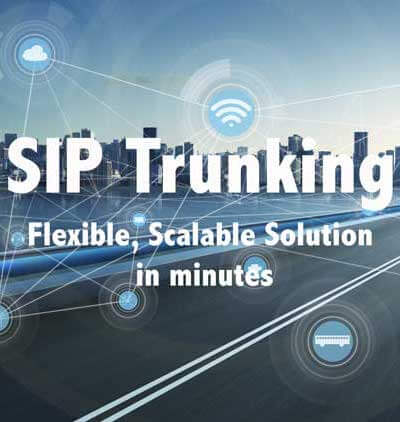How to troubleshoot common SIP problems? SIP, or Session Initiation Protocol, is a popular protocol used for VoIP communications. As with any technology, issues can arise with SIP, which can impact the quality and reliability of your communications. Here are some...
SIP Trunking Implementation: Common Challenges and How to Overcome Them
SIP Trunking Implementation: Common Challenges and How to Overcome Them
SIP trunking is revolutionizing the way businesses connect their phone systems to the internet, providing unparalleled flexibility and cost savings. However, the implementation of SIP trunking can be a complex process that comes with its own unique set of challenges. In this document, we will explore these challenges in detail and provide actionable solutions to help businesses overcome them.
From ensuring network readiness to maintaining call quality and number porting, implementing SIP trunking can be a daunting task. But fear not, we will discuss each challenge in depth and offer practical solutions to help you navigate the deployment process.
As businesses seek to optimize their communication systems, the demand for SIP trunking is expected to rise. However, it is important to understand the challenges that come with this technology and how to overcome them. By the end of this document, you will have a comprehensive understanding of the challenges associated with implementing SIP trunking and how to tackle them head-on to ensure a smooth and successful deployment.
Network Readiness
Network readiness is the first and foremost factor to consider before implementing SIP trunking. Network readiness involves having enough bandwidth to support voice traffic, configuring quality of service (QoS) settings to prioritize voice traffic, and ensuring proper firewall and security settings are in place.
To ensure network readiness, the first step is to conduct a thorough network assessment to determine the current network capacity and requirements for SIP trunking. This assessment will help identify potential bottlenecks and allow for the proper configuration of QoS settings. Additionally, ensuring that the firewall and security settings are properly configured will help prevent any security breaches or malicious attacks on the network.
Interoperability
Interoperability is the ability of different systems to work together seamlessly. With SIP trunking, interoperability refers to the compatibility of the SIP trunking service with the existing phone system or PBX (Private Branch Exchange) hardware.
Before implementing SIP trunking, it’s crucial to ensure interoperability by checking the compatibility of your existing phone system with the new service. To do this, you can refer to the documentation provided by your SIP trunking provider or reach out to their support team for assistance.
It’s worth noting that some cases may require additional hardware or software to enable interoperability, so it’s essential to plan for this well in advance. By taking these steps, you can ensure a smooth and successful implementation of SIP trunking that maximizes the benefits for your business.
Call Quality
Call quality is a crucial factor in any phone system deployment. With SIP trunking, call quality can be affected by factors such as latency, jitter, and packet loss, which can cause voice distortion, dropped calls, and other issues.
High call quality is a top priority when implementing SIP trunking. To achieve this, it’s crucial to prioritize voice traffic with Quality of Service (QoS) settings, and utilize a reliable internet connection with sufficient bandwidth.
Furthermore, monitoring and analyzing call quality metrics on an ongoing basis can help identify any issues and allow for quick resolution, ensuring that your SIP trunking system consistently delivers the highest quality calls possible. By following these guidelines, your business can confidently reap the benefits of SIP trunking while ensuring optimal call quality.
Number Porting
Number porting is the process of transferring phone numbers from one provider to another. With SIP trunking, number porting can be a complicated process that requires coordination between the existing provider, the SIP trunking provider, and the business.
Porting phone numbers from one provider to another can be a challenging process, and it’s no different when implementing SIP trunking. To simplify the number porting process, it’s important to work closely with both the SIP trunking provider and the existing provider.
It’s crucial to ensure that all the necessary documentation is provided to both providers and that the porting process is completed in a timely manner. The SIP trunking provider should have a dedicated team to handle number porting, and you can coordinate with them to ensure a smooth process.
It’s also important to plan for any potential downtime during the porting process. In some cases, the process can take longer than expected or encounter unforeseen issues that may impact business operations. To minimize any negative effects, it’s crucial to have a plan in place to handle such situations, including backup communication methods if necessary.
Working closely with both providers, planning ahead, and having backup communication methods can simplify the number porting process and ensure that your business can continue to operate smoothly.
Security
Security is a critical factor in any phone system deployment. With SIP trunking, there are potential security risks that need to be addressed, such as malicious attacks and toll fraud.
To maintain security with SIP trunking, it is crucial to implement robust security measures. This includes configuring firewalls and utilizing encryption to secure your system against potential cyber threats.
In addition, monitoring call patterns and usage on a regular basis can help to detect any unusual activity that may indicate toll fraud or other security breaches. By staying vigilant and proactively monitoring call patterns, your business can quickly identify and respond to potential security threats.
Overall, implementing strong security measures and regularly monitoring call patterns and usage are critical to ensuring the security of your SIP trunking system. By taking these precautions, you can protect your business from potential security breaches and safeguard your communication system.
Technical Expertise
Implementing SIP trunking requires a certain level of technical expertise, including knowledge of networking, VoIP, and SIP protocols.
To successfully overcome the challenge of implementing SIP trunking, it’s crucial to partner with a qualified SIP trunking provider who can offer guidance and support throughout the entire process. The provider should have a dedicated team of experts who can assist in the planning, configuration, and ongoing management of your SIP trunking system.
In addition to working with a provider, it’s important to invest in training and education for your IT staff and end-users. Proper training can help ensure that everyone is familiar with the new technology and can use it effectively. It can also help reduce the risk of user error, which can impact call quality and overall system performance.
Ongoing education and training should also be a priority to keep up with any updates or changes in the technology. This will help ensure that your SIP trunking system remains up-to-date and operates at its full potential.
Therefore, implementing SIP trunking can come with several challenges that need to be addressed for a successful deployment. By addressing network readiness, interoperability, call quality, number porting, security, and technical expertise, businesses can minimize the risk of any issues and ensure a smooth transition to SIP trunking.
Why to manage a phone system
when you can get for free.
New Posts
How to troubleshoot common SIP problems?
Maximizing Reach and Engagement: The Top Benefit of SMS Marketing for Your Agency
Maximizing Reach and Engagement: The Top Benefit of SMS Marketing for Your Agency As a marketing agency, you know that reaching and engaging with your target audience is key to your success. SMS marketing can be a powerful tool to help you achieve this goal. By...
SIP Trunking and Disaster Recovery: Ensuring Business Continuity
SIP Trunking and Disaster Recovery: Ensuring Business Continuity Disasters, whether natural or man-made, can significantly impact a business's operations. They can cause disruptions, lead to financial losses, and even result in the closure of the business. As such,...
Learn more about our Products
Visit SIP Trunking Pricing to see which plan best suits your business!
Our plans have been packaged together to give you optimum output.








